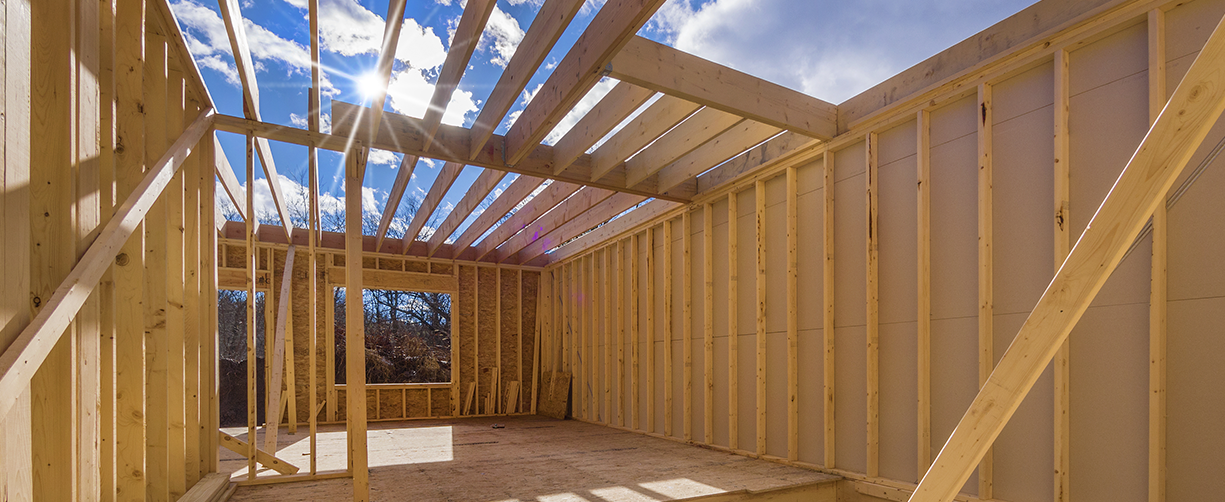All About Structural Timber

A wide range of timber materials is required on almost all construction projects. Even the masonry properties contain wooden elements like joists or studs. In this article, we will deal with different types of timber and provide guidance on its selection.
Selection by the type of timber
First of all, there is a distinction between hardwoods and softwoods. Hardwoods are more expensive as they are obtained from deciduous trees, which take longer to grow and are considered stronger and higher quality than softwoods harvested from coniferous trees. Softwood is also commonly used in construction, for instance, in carpentry. Some hardwoods and softwoods are used either in first fix carpentry– construction or second fix carpentry- decorative or in both.
| HARDWOODS | DESCRIPTION | USAGE |
| Oak | Strong construction material, used both as a structural and decorative element | Decorative beams, flooring, kitchens, skirting, architrave |
| Beech | A straight-grained hardwood | Worktops, floors, decorative features |
| Teak | Used in second fix to provide high quality finish | Staircase, garden features |
| Idigbo | Easy to work with, good value for money | Windows, staircase |
| Mahogany | Used in furniture industry | Furniture |
| Maple | Decorative hardwood | Decorative flooring |
| American balck walnut | Used in interior joinery | Kitchens, veneers |
| SOFTWOODS | DESCRIPTION | USAGE |
| Pine | Most commonly used | First and second fix |
| Cedar of Lebanon | Used in internal joinery | First and second fix |
| Western Red Cedar | Mainly used in exteriors | Boarding, shingles, decking |
| Douglas Fir | Commonly used in plywoods | Construction, decking |
| Hemlock | Light wood | Doors and windows |
Selection by the timber features
Seasoned features or treated features are not exclusive. The wood can be both treated and seasoned if required.
Seasoned wood contains high moisture levels and needs to dry out before usage. This is called seasoning. Wood can distort during the drying process, and often it has moisture long after seasoning. The distorting can be avoided when the wood is stored horizontally, above ground level and supported along the length.
Seasoned kiln-dried timber- artificially dried wood with accelerated seasoning. It is expensive but less prone to distortion.
Treated wood is stronger than non-treated wood but less resilient than pressure-treated wood. The degree to which wood has been treated impacts its lifespan.
Pressure-treated wood is usually impregnated with preservatives, and it is with green or brown tinge. Such timber can contact surfaces like soil and is more resistant to dampness or insects.
The second fix carpentry (skirting or doors) does not require treated timber, while the first fix carpentry (for instance, rafters or stud walls) needs treated wood.
Reclaimed timber is old and, in most cases, has been very well seasoned. There are, for instance, reclaimed floorboards on sale.
Selection of rough-sawn wood or planed wood
Wood is measured when it is rough-sawn and is priced based on its dimensions. However, the actual nominal sizes might be different due to shrinkage during the drying process, while in the case of planed wood, nominal dimensions will be smaller as it has been planed on all sides. Merchants more often sell timber in the exact dimensions (standard sizes), but it is worth checking before ordering.
Rough-sawn wood has a rough surface, so it is used where it will not be visible, for instance, in stud walls. Its dimensions are quite adequate as it is measured when rough-sawn.
Planed wood is used where it will be visible, for instance, skirting. It has been planned after being measured, so its dimensions might differ from what is stated.
Selection by timber grades
Timber is graded in strength classes, and grades denote a group of species and strength grade combinations. Strength classes vary from C14 to C50 for softwood and D18 to D70 for hardwoods. The higher the grade, the stronger the timber. The most common timber grades are C16 and C24. C16 is stronger than C24 timber. Additional features that add to a particular grade are strength, stiffness, density, number of knots, grain slope, species, origin etc.
Graded timber is mostly kiln-dried but can also be wet-graded (which is moisture content at ambient levels and not kiln-dried). Regularised means the product has a machined finish with a regular, consistent section size.
After the assessment, each piece of wood is stamped with the appropriate mark, which contains timber condition (dry graded), strength class (C16), reference, species group and certification body.
Timber marked as dry is graded at a maximum moisture content of 20% and should be transported, stored and installed in the way so this moisture content will not be exceeded.
Span tables show timber sizes and strengths and allow you to choose the size of timber necessary to give adequate support to flooring, ceiling or roofing.
Tips on buying wood
- Defect-free wood costs more, but its lifespan is more prolonged.
When buying wood, check it for splits, knots or uneven grain. Splits mean that wood might have dried too rapidly or been incorrectly stored. Softwoods can be damaged easily at storage. A warped timber might be challenging to see and have been twisted. Knots are especially unwelcome in second fix carpentry as they might be visible through paint or bleeding. It is best to treat them with a knotting solution.
- Find out whether the wood has been treated or seasoned or both
- Find out how wood has been stored
- Check if it is damped
- Find out if a merchant sells it in nominal or standard sizes to estimate the appropriate quantity
TIMBER ACCESSORIES
The most appropriate fixings for wood boards are screws, brackets, hangers or nails and pins.
Screw types vary to suit different applications. For instance, traditional wood screws (KDH silver) are tapered shanks and fit tight. There are also untapered wood screws (KDH gold) which are less likely to split wood. Drywall black-phosphate-coated (KSGD) is used to fix the plasterboard to studwork. MDF screws are sharp-pointed and twin-thread, while wax-coated screws are recommended for chipboard. Dowel screws are threaded at both ends to join two pieces of wood.
Nails are the most basic and essential fixings. They are available in various sizes and are for general use. Most are made of steel and iron; some are galvanized. Typically they are sold by weight.
Pins are very thin and have small heads, making them less likely to split wood.
Timber brackets and hangers are used for timber-fixing applications. There is a wide selection available. Mention the most common angle brackets and ties used for both heavy and light-duty fixing. Also, there are timber-to-masonry or timber-to-timber joists hangers. Restraint straps connect timber floor and roof system to masonry and provide required restraint. For instance, post bases are used for heavy-duty applications to fix timber posts into concrete. Racking solutions provide resistance to timber frame structures.
WOOD-BASED BOARDS- SHEET MATERIAL COMPARISON
Wood-based boards are commonly used in both first and second fix carpentry. Sheets are used to structuring or cover large surfaces. The description and comparison table below shows using different wood-based board types.
| WOOD BASED BOARD TYPE | DESCRIPTION | USAGE |
| Plywood |
It is formed with the layers of wood bonded together (3-Ply, 5-Ply, Multi-Ply), with adjacent are with their wood grain rotated up to 90 degrees to one another what creates very strong board. Its thickness varies and the most common sizes of sheet are 2400mm x 600mm or 2400mm x 1220mm. Highly versatile product. Can be manufactured from various wood types- softwood (easily cut, drilled), hardwood (ideal for furniture), marine (ideal for external use) to be suitable for various purposes, even for heavy duty applications. It costs more than OSB and it has higher stiffness than OSB board. |
Ideal for roofing, flooring, hoardings, boxing and decorative purposes. Exterior and interior usage. |
| Shuttering plywood | Wood composite sheet that is resistant to moisture penetration and do not stick to concrete. It can be used for shuttering, hoarding and other construction purposes, not suitable for prolonged external use unless suitably covered. Not suitable for decorative purposes. | Only exterior usage. Various purposes- shuttering, hoarding |
| WBP plywood | A high quality plywood especially for use in domestic, light industrial and commercial applications. It is manufactured with the external Water and Boil Glue which is a form of treatment for making plywood water resistant and applicable externally. | Exterior and interior usage |
| OSB board | Oriented strand board, engineered board, consists of compressed layers of wood and adhesive with standard dimensions of 2240x1220mm. Strong and stiff, water resilient, a cheaper alternative to plywood or chipboard . Different grades of the product are available for different levels of loading and different environmental conditions. | Variety of load-bearing applications- flooring, roofing, underlayment, interior fitments, etc. |
| Block board | Contains similar features to plywood, two layers of wood durable. | For furniture |
|
Medium-density fibreboard (MDF) |
Composed of compressed wooden fibres. It is strong structural element. Available in various thicknesses and veneering options. MDF board when cut gives the dust- use of the face mask is obligatory. There are lightweight and water resistant options. |
Decorative carpentry- shelving, furniture units, window sills, etc. |
| Moisture-resistant MDF | A version of MDF which is resists moisture attack. It has green colour. | Used in kitchens and bathrooms |
|
Fibreboard |
A light version of MDF. |
Underlay for flooring, or as an alternative to plasterboard on a ceiling |
|
Chipboard |
Composed of small wooden fibres. No decorative features, available in various thicknesses. | Alternative to floorboards |
|
Moisture-resistant chipboard |
More water-resistant than normal chipboard. Coloured green for easy recognition. |
Flooring |
|
Veneered chipboard |
Decorative wooden veneer | Commonly used for furniture, shelves |
|
Hardboard |
Thin, compressed fibreboard. One smooth side, one rougher side. | Used as a subfloor, or for kitchen units with melamine surface or veneer |







